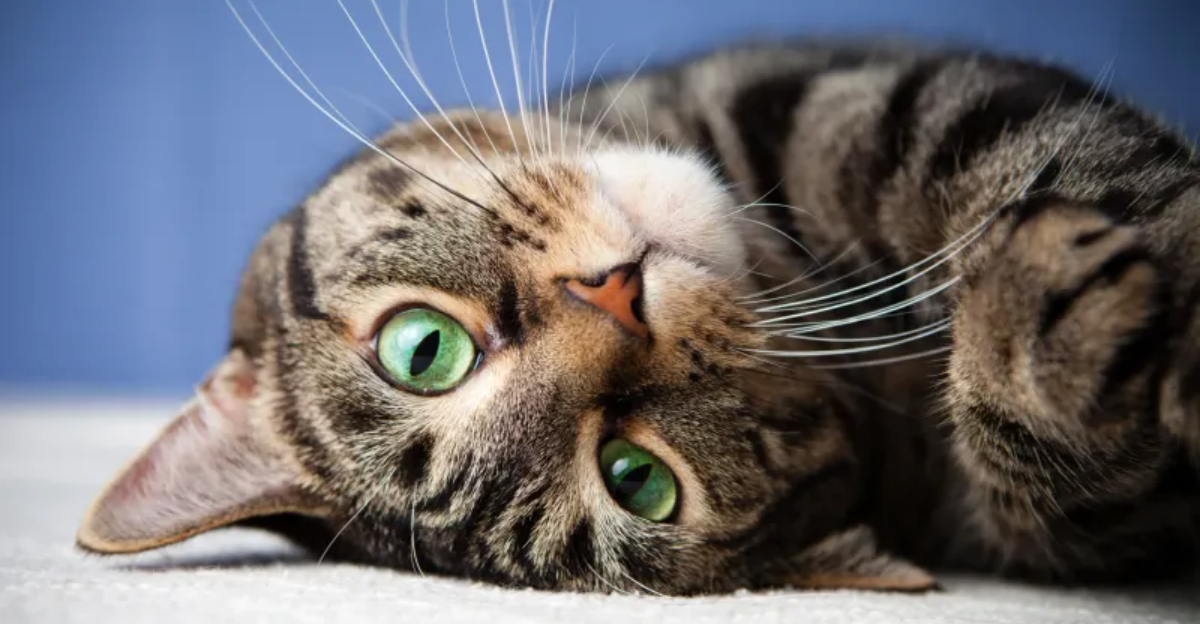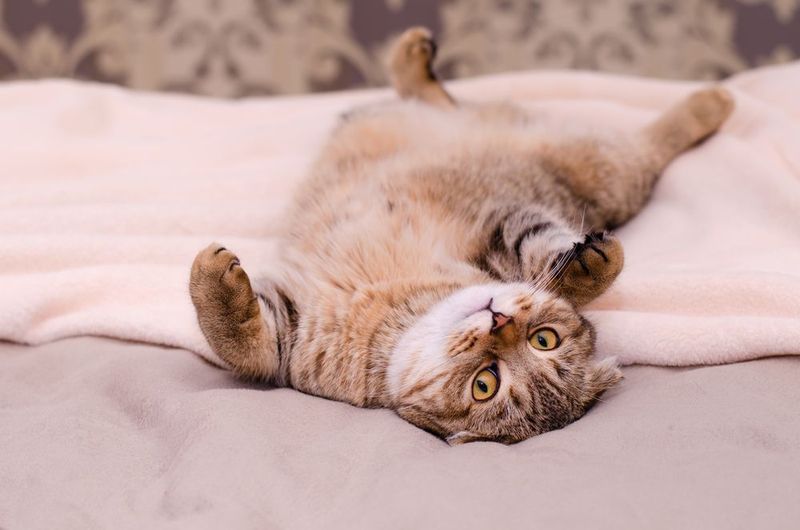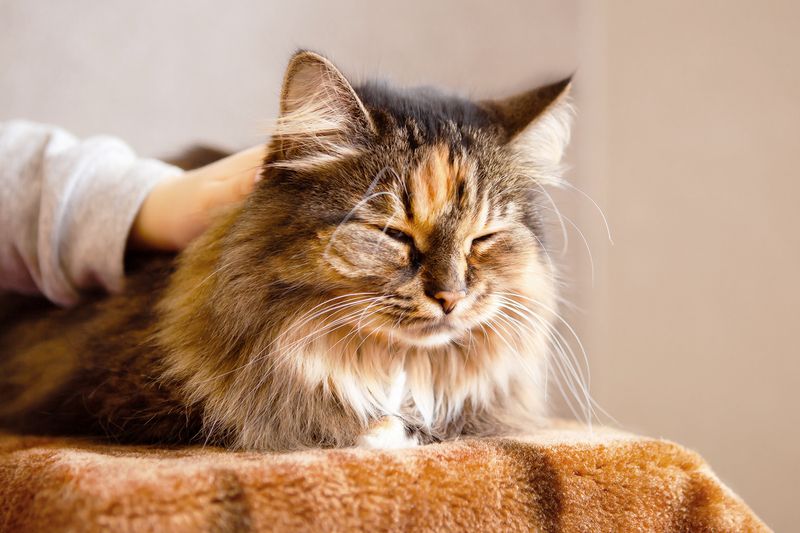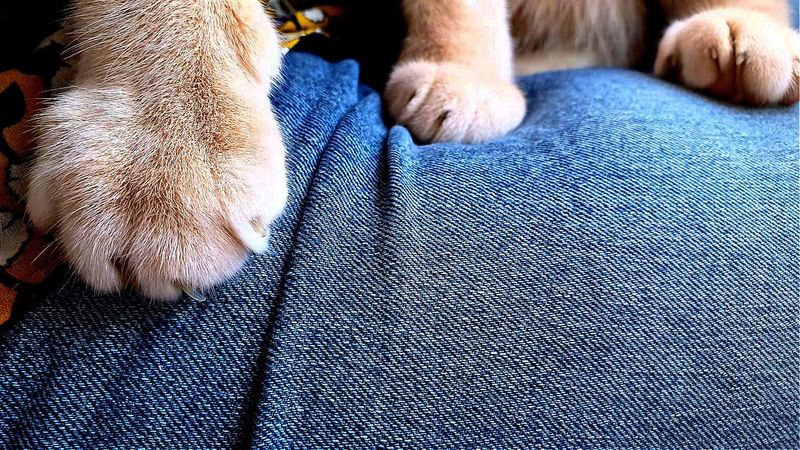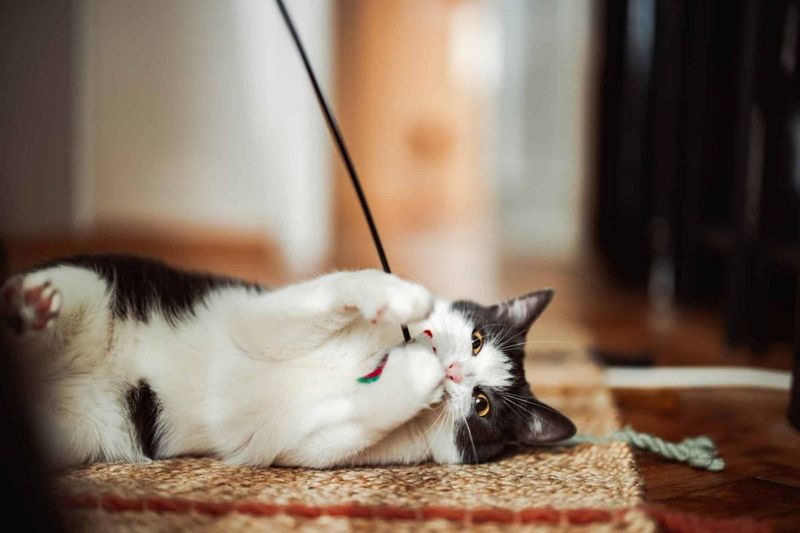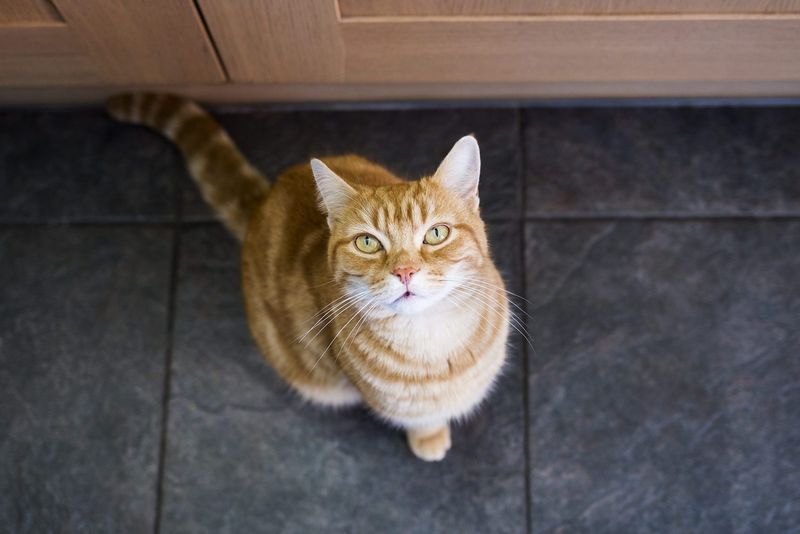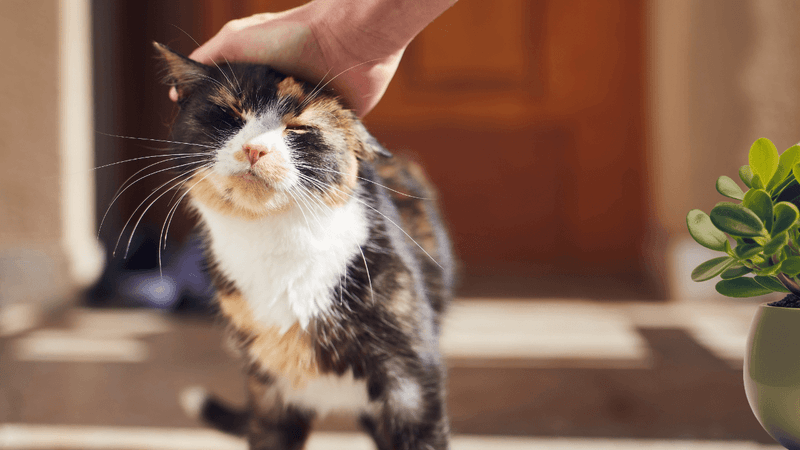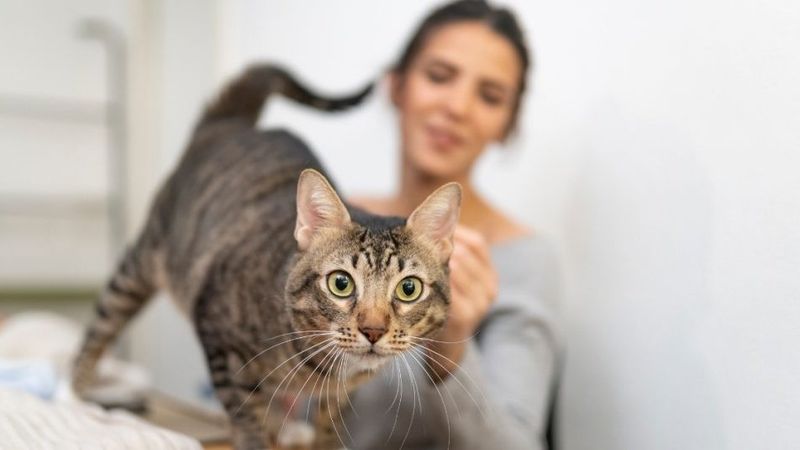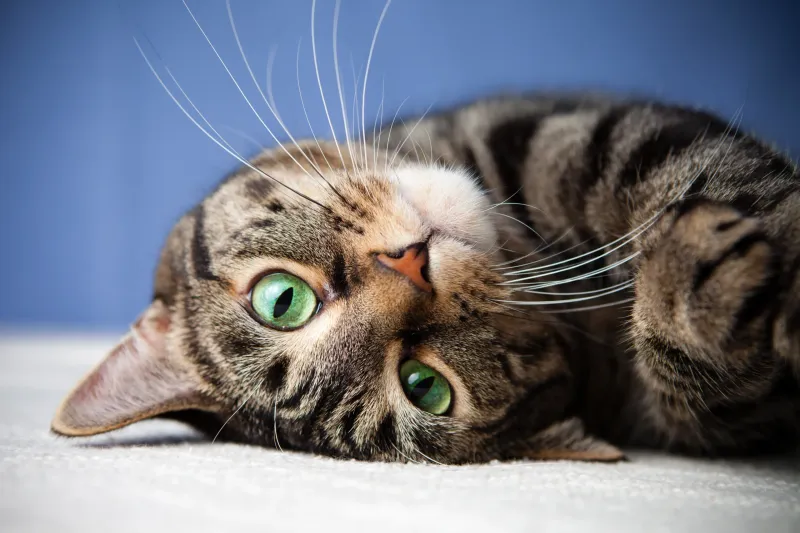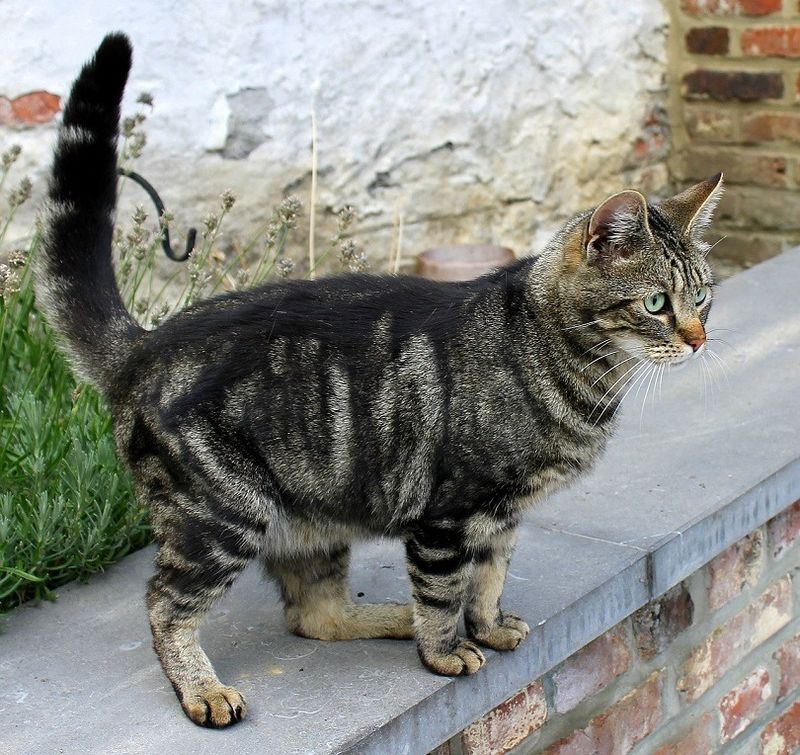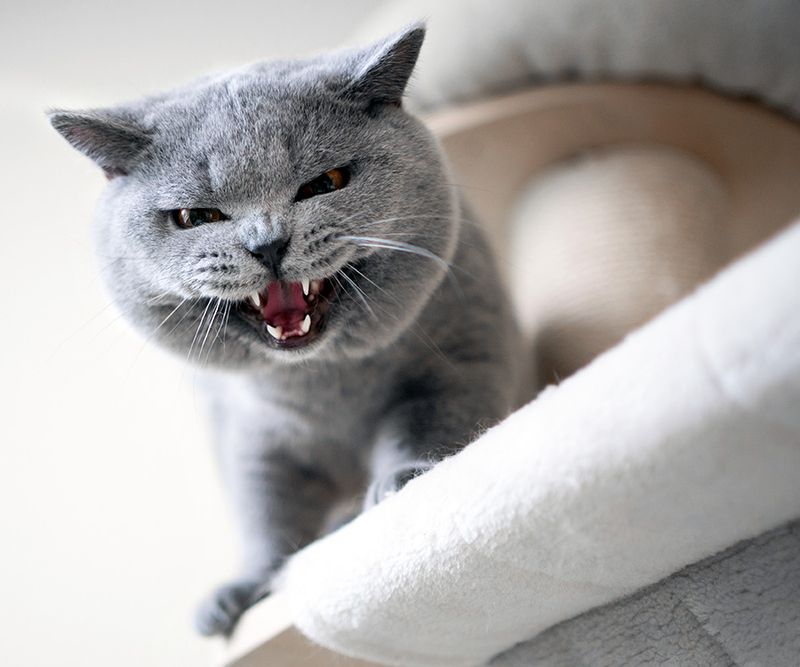📖 Table of Content:
- 1. Belly Exposure Without Defense
- 2. Slow Blinking Communication
- 3. Kneading Your Lap
- 4. Bringing You “Gifts”
- 5. Following You to the Bathroom
- 6. Sleeping on Your Chest or Face
- 7. Head-Butting and Cheek Rubbing
- 8. Exposing Their Back to You
- 9. Grooming You
- 10. Purring While Making Eye Contact
- 11. Greeting You with an Upright Tail
- 12. Showing Their Back Teeth During Play
Cats have a reputation for being independent and sometimes aloof, but they’re actually deeply emotional creatures. Building trust with a cat takes time and patience, but the rewards are absolutely worth it. Once your feline friend decides you’re worthy of their complete trust, they’ll reveal a whole new side of their personality through these special behaviors that only their closest humans get to witness.
1. Belly Exposure Without Defense
A cat rolling over and showing you their belly isn’t just cute – it’s a major trust milestone. The stomach area is a cat’s most vulnerable spot, containing vital organs with little protection.
Wild cats would never expose this area to potential threats. When your cat stretches out and reveals their soft belly without immediately arming those back claws for defense, they’re essentially saying, “I trust you completely with my life.”
Many cats will still react defensively if you actually touch the exposed belly – that’s normal! The belly display itself is the gesture of trust, not necessarily an invitation to pet. It’s their way of demonstrating they feel totally safe in your presence.
2. Slow Blinking Communication
Those languid, slow blinks your cat gives you across the room are actually a form of feline affection. Cat behaviorists call these “cat kisses” because they represent a deliberate display of vulnerability and comfort. In the wild, closing eyes around another creature would be dangerous.
When your cat chooses to slowly close and open their eyes while gazing at you, they’re communicating profound trust. This silent exchange is something cats reserve only for those they consider safe and beloved.
Try returning the gesture by slowly blinking back. This creates a beautiful nonverbal conversation between you and your feline companion that strengthens your bond.
3. Kneading Your Lap
Remember those tiny paws rhythmically pressing into your lap? This behavior, often called “making biscuits,” stems from kittenhood when cats kneaded their mother’s belly to stimulate milk flow. As adults, they only perform this vulnerable nursing behavior with humans they deeply trust.
The rhythmic motion of their paws indicates your cat feels secure enough to regress to this comforting kitten behavior. It’s both a self-soothing action and a compliment to you as their trusted caregiver.
Some cats even drool slightly while kneading, further evidence they’ve mentally returned to that safe, nurturing kittenhood state – a transformation they’d never allow around someone they don’t trust completely.
4. Bringing You “Gifts”
Finding a toy mouse or, more alarmingly, an actual dead critter at your doorstep? Your cat isn’t being cruel – they’re showing profound trust by sharing their hunting success with you.
Cats are natural hunters who view their humans as part of their family group or colony. In feline society, bringing prey to another cat or kitten is a teaching behavior and sign of care. When your cat presents you with these offerings, they’re treating you as a valued family member they want to provide for and teach.
Rather than scolding this behavior, acknowledge it with calm praise. Your cat is demonstrating they consider you worthy of their most prized possessions and hunting achievements.
5. Following You to the Bathroom
Your cat’s determination to join your bathroom visits isn’t just curiosity – it’s a significant trust behavior. Cats are at their most vulnerable while eliminating, which is why they’re so selective about their litter box locations in the wild.
When your cat insists on accompanying you to the bathroom, they’re demonstrating they trust you during vulnerable moments and expect the same protective presence from you.
This behavior often develops only after a cat feels completely secure in their relationship with you. Many cats will even maintain eye contact while using their litter box – not because they lack privacy but because they’re trusting you to watch for potential threats while they’re vulnerable.
6. Sleeping on Your Chest or Face
A cat who chooses to sleep directly on your chest, face, or neck is displaying extraordinary trust. Sleep is when animals are most defenseless, and your cat’s choice to doze off near your face puts them near your mouth and eyes – potential threats in the animal world.
The warmth and rhythm of your breathing create a comforting environment, but the primary motivation is trust-based. Your cat is essentially saying they feel so secure with you that they can surrender to complete vulnerability.
This behavior is particularly meaningful because cats are both predators and prey in nature, making deep sleep a potentially dangerous state they only enter when feeling absolutely protected.
7. Head-Butting and Cheek Rubbing
That forceful nudge against your hand or face is more than just attention-seeking behavior. When your cat head-butts you (officially called “bunting”), they’re activating scent glands in their forehead and cheeks to mark you as their trusted territory.
Cats only share their personal scent with objects and beings they consider safe and part of their inner circle. This behavior represents a biological claiming – your cat is essentially telling other animals, “This human belongs to me.”
The intensity and frequency of head-butting typically increases as trust deepens. Cats reserve their most enthusiastic bunting for their most trusted companions, making this seemingly simple gesture a profound declaration of feline confidence in your relationship.
8. Exposing Their Back to You
When a cat turns their back to you, it’s a powerful sign of trust. In the wild, exposing their back leaves them open to danger, so doing this around you means they feel safe and secure. When your cat sits with their back to you or sleeps with their spine against your leg, they’re communicating absolute confidence in your intentions.
They’re essentially saying, “I know you won’t hurt me even when I can’t see what you’re doing.”
This position also often indicates your cat views you as a protector who watches over them while they relax. It’s a subtle but meaningful role reversal from their typically vigilant nature.
9. Grooming You
When your cat begins licking your hand, arm, or even your hair, they’re engaging in a deeply significant trust behavior called allogrooming.
In cat colonies, mutual grooming only occurs between cats who share strong social bonds and complete trust. Your cat’s rough tongue might feel strange, but this behavior represents their acceptance of you as family. They’re helping clean you (as they would a trusted cat companion) and simultaneously marking you with their scent.
Cats are fastidious about cleanliness, so sharing their grooming routine with you indicates they consider you worthy of their highest form of care. This behavior rarely emerges until a cat feels profound security in their human relationship.
10. Purring While Making Eye Contact
Purring combined with direct eye contact represents a powerful trust signal from your cat. While cats purr for various reasons, including self-soothing when stressed, the combination of purring while maintaining eye contact is reserved exclusively for deeply trusted companions.
Eye contact is generally threatening in the cat world, which is why unfamiliar cats avoid it. When your cat holds your gaze while rumbling with contentment, they’re demonstrating exceptional comfort in your presence.
This dual-signal behavior often emerges only after months of relationship-building. The next time your cat purrs while looking directly into your eyes, recognize it as one of the highest compliments in feline language.
11. Greeting You with an Upright Tail
The straight-up tail position when your cat approaches you is their equivalent of an enthusiastic wave. This distinctive greeting, with tail held high and often slightly curved at the tip, is exclusively reserved for humans and fellow cats they genuinely adore.
Wild cats keep their tails low for protection and stealth. Raising the tail high exposes vulnerable areas and broadcasts their presence – something cats only do when they feel completely secure.
The quiver or slight shake sometimes seen at the tip of the raised tail indicates especially intense excitement at seeing you. This greeting behavior develops only after a cat has established firm trust in your relationship and genuinely looks forward to your interactions.
12. Showing Their Back Teeth During Play
During playful moments, a truly trusting cat might roll over and flash their back teeth in what appears to be a smile. This behavior, sometimes called a “play face,” reveals the cat’s most powerful weapons – their rear molars used for crushing prey – in a deliberately non-threatening context.
Cats only display this vulnerable expression when they’re completely comfortable that play won’t escalate into actual aggression.
The slight opening of the mouth with visible back teeth is their way of saying, “I trust you enough to show my weapons without using them.” This playful expression is particularly significant because it represents your cat feeling secure enough to engage in mock hunting behaviors without fear of real conflict.
